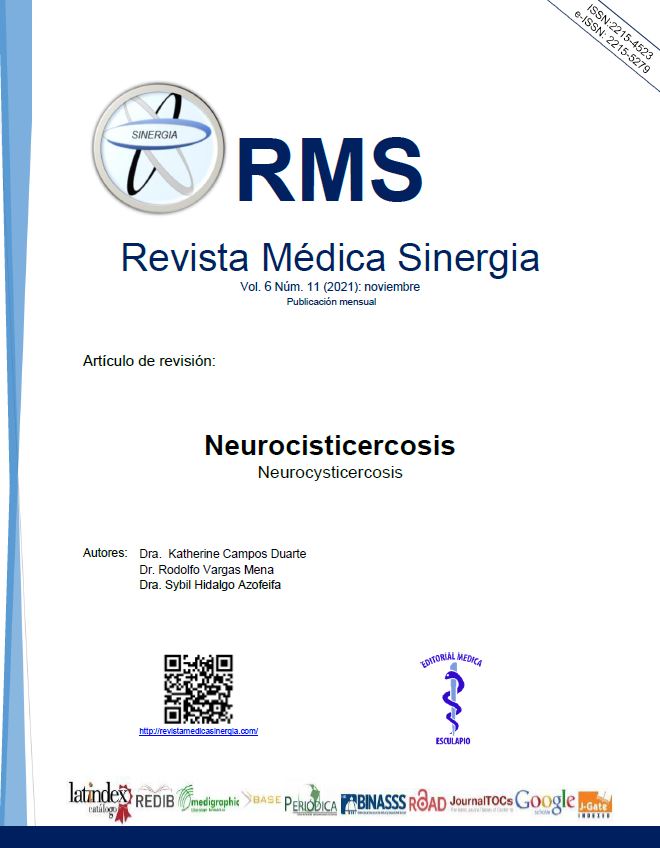Abstract
This article addresses the most up-to-date literature on infection by Taenia solium cysticerci that invade the central nervous system. It begins briefly with the life cycle of the parasite and how both pigs and humans acquire it. It addresses epidemiological data based on the most up-to-date studies not only of larger populations, but also of those areas in which the disease is considered endemic and that therefore have more experience in the management of the disease. An extensive explanation of the clinical presentation in the different areas most affected within the CNS is provided; How to reach the diagnosis is developed in detail, from the most classic to the most up-to-date, not only clinical diagnosis is mentioned, but also through images and laboratories. At the end of the article, treatment recommendations are provided in those settings in which the patient is eligible to be treated and it closes with conclusions so that the reader can summarize the key points.
Keywords
References
White AC Jr, Coyle CM, Rajshekhar V, et al. Diagnóstico y tratamiento de la neurocisticercosis: Guías de práctica clínica de 2017 de la Sociedad Estadounidense de Enfermedades Infecciosas (IDSA) y la Sociedad Estadounidense de Medicina e Higiene Tropical (ASTMH). Clin Infect Dis 2018; 66: e49.
Debacq G, Moyano LM, García HH, et al. Revisión sistemática y metaanálisis que estiman la asociación de cisticercosis y neurocisticercosis con epilepsia. PLoS Negl Trop Dis 2017; 11: e0005153.
Del Brutto OH, Arroyo G, Del Brutto VJ, et al. Sobre la relación entre la neurocisticercosis calcificada y la epilepsia en una aldea endémica: un estudio poblacional a gran escala basado en tomografía computarizada en una zona rural de Ecuador. Epilepsia 2017; 58: 1955.
Moyano LM, O'Neal SE, Ayvar V, et al. Alta prevalencia de neurocisticercosis asintomática en una comunidad rural endémica del Perú. PLoS Negl Trop Dis 2016; 10: e0005130.
Okello AL, Thomas L, Inthavong P, et al. Reimpresión de "Evaluación del impacto de un paquete de intervención conjunta humano-porcino para el control de Taenia solium: resultados de un estudio piloto del norte de la República Democrática Popular Lao". Acta Trop 2017; 165: 261.
Cisticercosis - Página 1 [Internet]. Mcdinternational.org. [citado el 24 de julio de 2021]. Disponible en: https://www.mcdinternational.org/trainings/malaria/spanish/dpdx/HTML/Frames/AF/Cysticercosis/body_Cysticercosis_page1
Coyle CM. Neurocisticerosis: un enfoque individualizado. Infect Dis Clin North Am 2019; 33: 153.
Nash TE, Ware JM, Mahanty S. Neurocisticercosis intraventricular: experiencia y resultado a largo plazo de un centro de referencia terciario en los Estados Unidos. Am J Trop Med Hyg 2018; 98: 1755.
Nash TE, O'Connell EM, Hammoud DA, et al. Historia natural de la neurocisticercosis subaracnoidea tratada. Am J Trop Med Hyg 2020; 102: 78.
Nash TE, Bustos JA, García HH, Grupo de Trabajo de Cisticercosis en Perú. Enfermedad centrada alrededor del granuloma calcificado de Taenia solium. Trends Parasitol 2017; 33:65.
García HH, O'Neal SE, Noh J, et al. Diagnóstico de laboratorio de neurocisticercosis (Taenia solium). J Clin Microbiol 2018; 56.
Carpio A, Fleury A, Romo ML, et al. Nuevos criterios diagnósticos de neurocisticercosis: fiabilidad y validez. Ann Neurol 2016; 80: 434.
Del Brutto OH, Nash TE, White AC Jr, et al. Criterios de diagnóstico revisados para la neurocisticercosis. J Neurol Sci 2017; 372: 202.
Bustos JA, García HH, Del Brutto OH. Confiabilidad de los criterios diagnósticos de neurocisticercosis para pacientes con lesiones quísticas ventriculares o granulomas: una revisión sistemática. Am J Trop Med Hyg 2017; 97: 653.
García HH, Lescano AG, Gonzales I, et al. Eficacia cisticida del tratamiento combinado con praziquantel y albendazol para la cisticercosis cerebral parenquimatosa. Clin Infect Dis 2016; 62: 1375.
Osorio R, Carrillo-Mezo R, Romo ML, et al. Factores asociados con la respuesta al tratamiento quisticida en la neurocisticercosis extraparenquimatosa. J Clin Pharmacol 2019; 59: 548.
Anand P, Mukerji SS, Thon J y col. Agentes ahorradores de esteroides para el tratamiento de la inflamación en la neurocisticercosis complicada. Neurol Neuroimmunol Neuroinflamm 2019; 6.
Frackowiak M, Sharma M, Singh T, et al. Fármacos antiepilépticos para el control de las convulsiones en personas con neurocisticercosis. Cochrane Database Syst Rev 2019; 10: CD009027.

This work is licensed under a Creative Commons Attribution-NonCommercial 4.0 International License.
Copyright (c) 2021 Array


